Basic System Vulnerability (BSV) paired sample tests.
Scope:
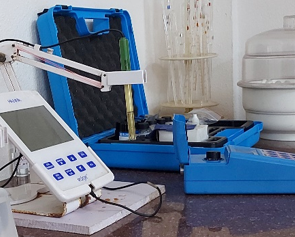
Physical & Sensory Parameters:
Colour (Appearance & True Colour Units), Odour, pH, Turbidity; Electrical Conductivity (EC) & Total Dissolved Solids (TDS) by gravimetry (TDSG).
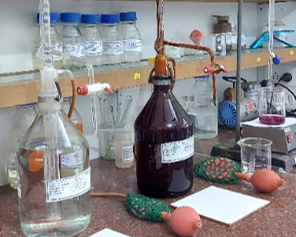
Chemical Parameters:
Free Residual Chlorine (Onsite by sample collector), Ammoniacal-Nitrogen (NH3-N), Nitrites (NO2) & Nitrates (NO3) & Chloride.
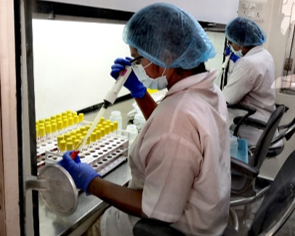
Bacteriological Parameters:
MPNMost Probable Number, MPNMost Probable Number, MPN (Total coliforms),
Thermotolerant coliforms (TTC) & E. coli.
Note: the biological parameters are same as in BCT.
Total parameters: 6 + 5 + 3 = 14
Rationale:
Figure 1: Basic Schema of Municipal Water Utilities
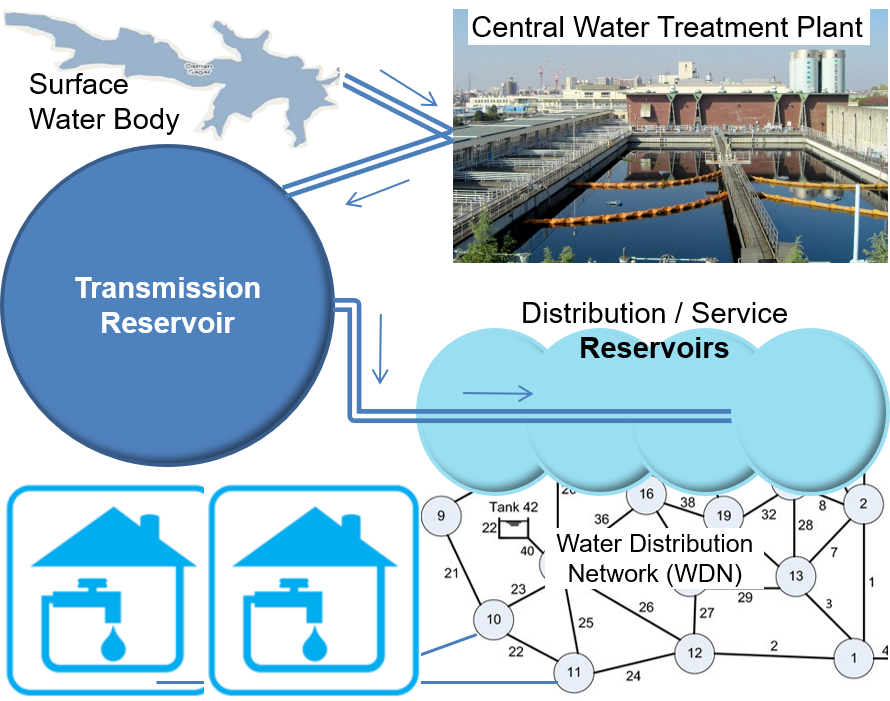
How does drinking water reach our homes? Most consumers having municipal water connections would know that drinking water reaches our homes through pipes. This seemingly simple service requires elaborate infrastructure, operations, maintenance and quality control arrangements to supply safe drinking water. Metro and municipal water utilities usually source water from various surface water bodies, such as dams & reservoirs built across rivers, irrigation canal systems, direct-draw from rivers, fresh water lakes, etc. Where surface water sources are unavailable or inadequate, and high yielding groundwater aquifers are available, cities and town may rely wholly or partially on borewells.
Despite, various water safety measures, the quality of water from each source would vary inherently and on account of varying exposure to contaminants. Central treatment plants (popularly called filter beds) clarify the water, perform quality checks and balance chemical parameters if required. Most important. Central water plants remove microbial contamination, and release water to transmission reservoirs, with enough residual chlorine to prevent recontamination during the course of transmission and storage. Transmission reservoirs feed a city-wide network of distribution reservoirs also known as service reservoirs. Each distribution reservoir serves a well-defined consumer area. The service reservoir distributes water to consumer premises through the municipal water distribution network (WDN) extending to street level water pipe lines. Water supply linemen operate control valves at various nodes of the distribution network to release water different blocks of the service area according to the water utility’s distribution plan. Consumer connections are tapped from street level water supply pipelines of the water supply distribution network (Fig-1). Residual chlorine dissipates during the course of transmission and storage enroute to service reservoirs. Hence, booster chlorination is done at service reservoirs to sufficiently raise the level of residual chlorine, to prevent recontamination during transit through the distribution network, and in consumer premises.
Sustained integrity of WDN from service reservoirs to consumer premises is a big challenge for water utilities. WDNs are subject to many vulnerabilities. Most networks consist of components built in different time periods. Material and specification of network components used in different time periods may vary. Weak segments consisting of old and damaged components are more vulnerable to backsiphonage. WDNs tend to change often due to extensions new connections, alternate and parallel pipelines to meet rising demand in same area, dead segments due to closure of connections, etc. Often these changes are ad-hoc solutions to pressing problems, without reference to alignment of existing network components. Ad-hoc changes in street sewer network tend to have a much greater impact on quality of water in WDN. Ideally, street sewers should run parallel and a specified minimum separation distance between water and sewer lines ought to be maintained. But in practice, deficiencies creep in. Older street sewers are stressed due to aging and rise in population density beyond its designed capacity. Choked and overflowing street sewers are a major source sewage contaminated waste water infiltration in the vicinity of water lines. Ad-hoc and unauthorized excavations and works tend to damages street sewers, and repair may be deficient, delayed or not happen at all. Damaged street sewer result in subsoil infiltration of waste water, acting as a ready source of fecal contamination for WDN.
Figure 2: Choked street-sewers & damaged water lines
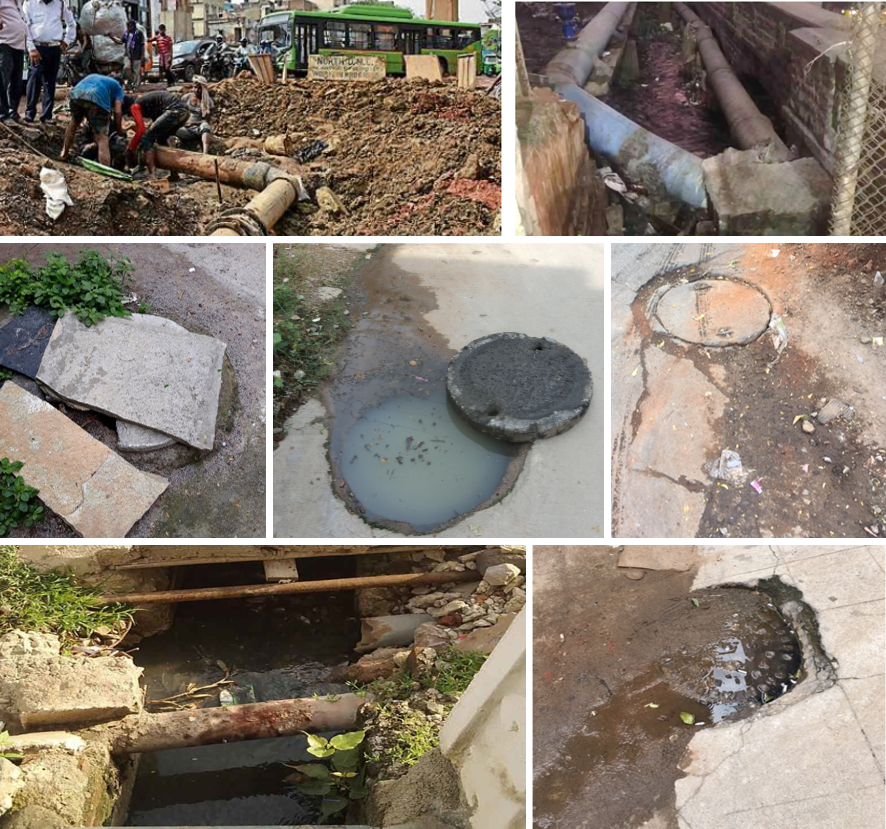
Intermittent supply schedules add another layer of vulnerability. In case of continuous supply, the WDN is filled with treated water at higher pressure in relation to its subsoil surroundings. Thus, even if there is some leak in the WDN pipeline, treated water may leak out and be lost, but contamination from the surroundings do not usually get a chance to enter into the water pipeline. The pressure inside water distribution pipeline drops when there is no supply, creating a scope of ingress of contaminated water from its surroundings, particularly if there are weaknesses and/or damages to the WDN and there is ready source of sewage in its immediate neighbourhood. Thus, aging and damaged WDNs, coupled with deficient or damaged street sewer systems increase the risk of backsiphonage resulting in fecal contamination of water supplied to consumers, even if quality of water released by central treatment plants is good.
Sewage intrusion into WDN changes the physical, chemical and microbial characteristics of finished water. For example; backsiphonage is sometimes associated with disagreeable odor (drainage or sewage smell), increased turbidity, and total dissolved solids (TDS). Excess of ammonia is an important indicator of faecal pollution. High level nitrites and nitrate indicate probable environmental and sewage contamination. Nitrites indicate recent contamination. Nitrates indicate older contamination. Presence of both may be due to a continuing source of contamination. Chloride in drinking-water originates from natural sources, sewage and industrial effluents. Plenty of total coliforms indicates that there may be some issues regarding cleanliness and integrity of the distribution system. Presence of thermotolerant coliforms suggests environmental pollution including the possibility of sewage contamination. Presence of E. coli is a definitive sign of sewage (faecal) contamination.
Integrity and functional status of a WDN can be inferred by analysing paired samples from the consumer-end and the concerned service reservoir and comparing observed values specific parameters that are known to be affected by intrusion of sewage. Bothe samples should be taken during the same supply period. Ideally, in case of a perfect WDN, quality parameters of water received at the consumer-end should be same as that of treated water released from the concerned service reservoir. In practice, the difference in observed parameter values of consumer-end sample and that of the service reservoir sample would be centred around zero. Depending on the extent of loss in functional integrity of a WDN, large differences may be observed between two samples, particularly in respect of parameters affected by backsiphonage.
Figure 3: Schema of Basic System Vulnerability (BSV), Paired Sample Tests
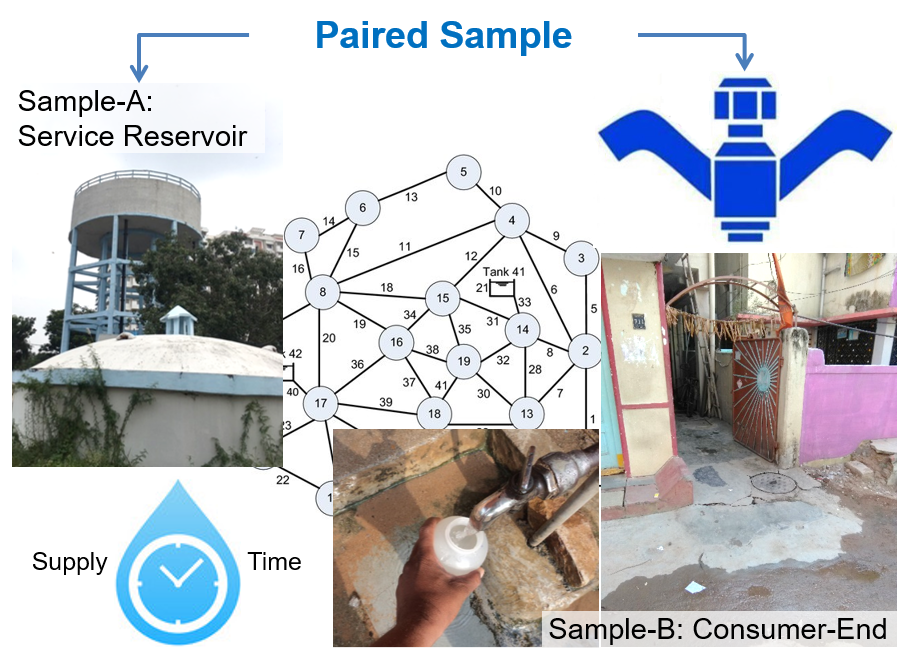
In BSV, we have included a set of parameters that are usually affected sewage contamination. Too many parameters would add to cost and complicate analysis. Hence, scope of the test is limited to a minimal set of parameters that would allow for identification of faecal contamination, give some idea about the prevalence and severity of sewage intrusion, with help of simple and manageable data analysis.
Incidence of backsiphonage event depends on environmental conditions and severity of WDN damage. Vulnerabilities due to ageing WDN, focal damages to WDN, other latent and developing vulnerabilities, may not always result in a backsiphonage event, particularly if environmental conditions around the WDN is protective enough. Hence, a number of BSV paired tests are usually required to identify and localize distribution system vulnerabilities. The exact sample size would depend on the size of WDN segment being investigated, the number of Service Reservoirs involved and the ease with which water supply distribution lines can be identified and accessed for sampling.
Sample - Collection, Storage & Transportation:
Follow methods of sampling specified in IS 3025 part 1 : 1987 for chemical tests and in IS 1622 : 1981 for bacteriological tests. Sample should be representative of the water to be tested and should be collected with utmost care to ensure that no contamination occurs at the time of collection or prior to examination by the laboratory.
Both consumer-end (sample-B) and the SR-end (sample-A) samples must be collected during live municipal supply within the same supply time window. Residual chlorine is to be tested on both ends at the time of sample collection. Hence a trained Water Quality Investigator skilled in residual chlorine testing is preferable.
Step-1: Gather all that you need for collection of water samples:
Samples are to be collected at two locations, supply-end (A) and consumer-end (B) for which you will need set of 1 Ltr (CBWS/ABWS) + 250ml (SBT) for each location - A & B. One litre sample collected in a clean and dry clear or amber colour polypropylene bottle (CBWS/ABWS) is required for physical and chemical tests. About 250 ml of water sample collected in a sterile bottle with thiosulfate (SBT) is required for bacteriological tests. You need a pair of sample collection bottles (1xCBWS + 1xSBT), two black or dark colour polythene bags (small garbage bag will do) to minimise exposure of samples to sunlight, ice packs to keep the sample bottles cool during transport and a carry bag for convenient transport.
Figure 4: Contents of a Basic DPD Rapid Test Kit for Free Chlorine
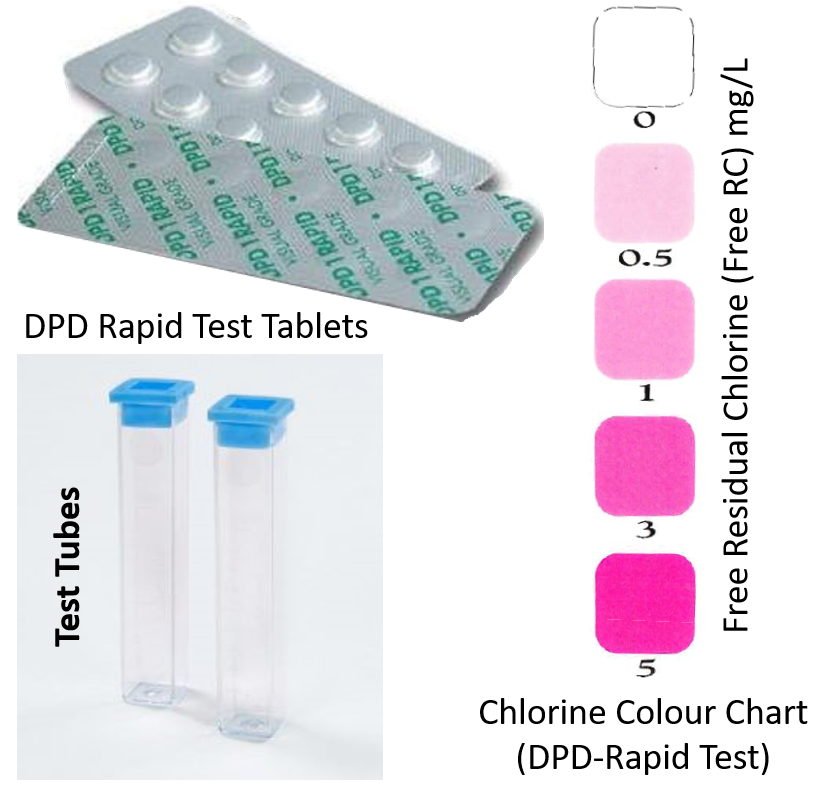
To test the level of residual chlorine in water, you will need a DPD rapid test kit for free residual chlorine. DPD stands for N, N-diethyl-p-phenylenediamine. The rapid test kit includes DPD tablets, a test tube with a mark for taking measured volume of water, and a printed chlorine colour chart. When added to a measured sample of water in a test tube, the rapid dissolving DPD tablets develop light to deep pink colour which can be visually compared with a colour comparator card. No change in colour means there is no residual chlorine. Deeper shades of pink mean higher levels of residual chlorine. Make sure that the DPD tablet is within its expiry date.
Gather adequate number of sample collection bottles and DPD tablets, depending on the number of paired sample tests to be done in the concerned area.
Step-2: Identify sampling point and time:
Inquire in advance about the municipal water supply time and supply duration to the concerned area. The entire sample collection operation at the consumer-end and the SR-end has to be completed during the same supply period. Hence, position yourself at the consumer-end at the beginning of supply period. Complete residual chlorine testing and sample collection at the consumer-end. Then proceed to the SR-end and collect the paired sample within the same supply period.
At the consumer-end, RC testing and sample collection should be from the direct municipal supply line. Many households usually provide an overground tap from the direct municipal supply line to catch drinking water. If such a tap is available, use the same as the sampling point. Often direct municipal supply lines terminate inside a sump. In that case, collect sample from inside the sump by collecting water from the municipal supply line as it falls into the sump.
At the SR-end identify a tap that delivers from the directly from the Service Reservoir or the municipal water supply distribution line.
Step-3: Collect sample:
- Wash both your hands with soap and water, wipe with a clean towel and let it dry. Request an assistant to wash his/her hands and standby.
- Label the sample collection bottles and place it within easy reach, but do not open at this stage. Have ice packs ready.
- Then flush the tap, delivery pipe, spout by letting water out for, say 2-3 minutes. Do not touch the tap or water flowing out. In case of narrow mouth container, ask the assistant to tilt the container and pour water to flush the mouth. In case of dip sample, create a clear zone by carefully placing bottom of sample bottle on water surface and moving it in a cyclical to motion to disperse floating debris, if any.
-
Test for Residual Chlorine:
- Use the test tube, DPD tablet and visual colour comparison chart provided by the same manufacturer for the given kit. Read and follow the steps as recommended by the available DPD Rapid Test kit. Do not mix and match test tube of one manufacturer with DPD tablet and/or visual comparison chart of another manufacturer.
-
The following steps are based LaMotte DPD #1R Test Tablet kits for residual chlorine.
- Fill the test tube to the 5 ml line.
- Add one Chlorine DPD #1R test tablet.
- Cap the tube and mix until the tablet has disintegrated.
- Compare colour of the sample with the Chlorine Colour Chart and read test result.
- Record test result in the sample collection record.
- Read test result as soon as the DPD tablet is dissolved. Delays may cause the colour to change resulting in inaccurate test results.
- Collect the sample for physical and chemical analysis first; followed by collection of bacteriological-sample.
- Hold the sample collection bottle and wait for flushing of tap, delivery pipe, spout or narrow mouth is complete. Hold the bottle in one hand and open and hold the cap in the other hand avoiding to touch inner side of the cap. Place opened bottle mouth under the tap, delivery pipe, spout or mouth of the container avoiding direct contact with the tap. Ask the assistant to open the tap, delivery pipe control or tilt the container to pour water into the bottle. As the bottle is about to be full, quickly remove the bottle away from water stream and replace cap tightly. Wipe outside of bottle dry with a clean and dry tissue or cloth.
- Place each bottle inside separate dark colour bags, tie ice packs around each of them and place it in a carry bag for transport to laboratory.
Figure 5: Field Testing of Residual Chlorine Using DPD – Rapid Tablets
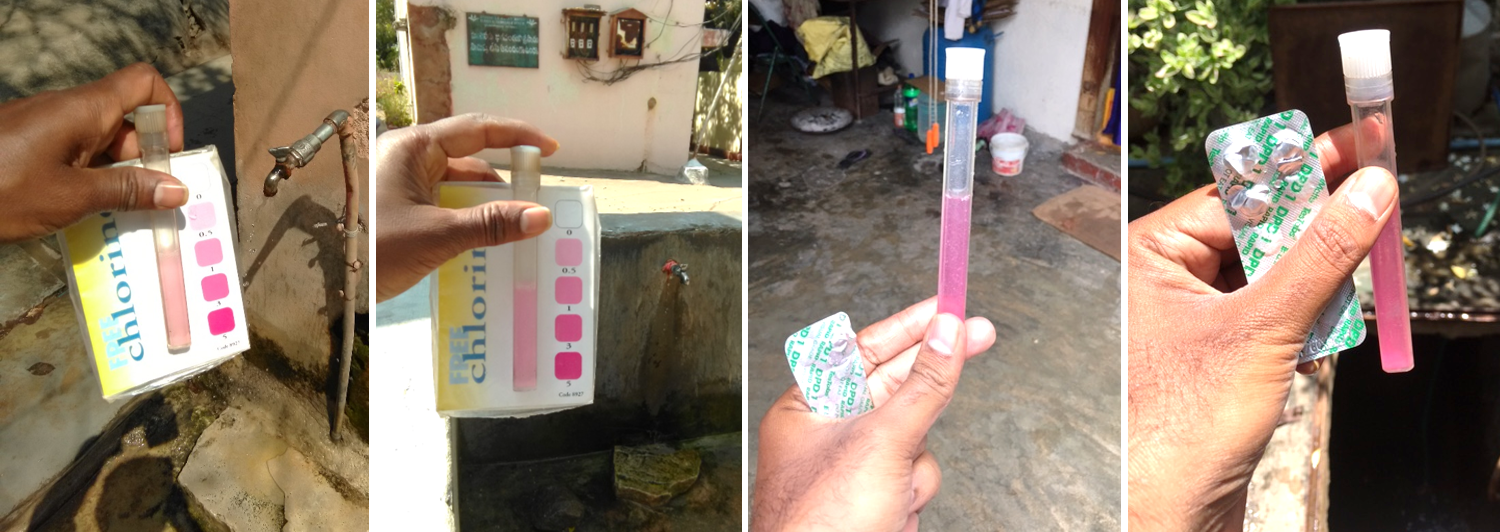
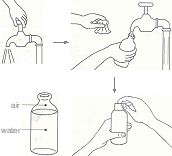
Step-4: Transport to laboratory:
Transport the samples to laboratory as soon as possible, preferably within six hours. Purpose of this test is to identify if there is any vulnerability in the distribution system. Storage of sample may introduce unknown interferences and reduce the diagnostic efficacy of the test. Hence, it is advisable to plan, so that samples are transported to the laboratory as soon as possible, without the need for any storage.
Information About Source, Context, Intended Use & Concerns:
Provide as much detail as you can about the source of water, sampling point, activities & environment around the sampling point, details of how the sampling point is linked to the municipal water supply line, time of collection of each sample, whether the sample was collected during live supply. These information help in interpretation of test results. Occasionally, the IHS Laboratory may contact you for clarifications and additional information about the source and its environment, to help interpretation of test results.
Test Method & Duration:
Physical and chemical characteristics of water sample are tested according appropriate parts of the IS3025 and/or American Public Health Association (APHA). For bacteriological analysis methods specified in IS1622 of 1981 are used. Report will be available in 3 to 5 days, depending on duration of bacteriological analysis and gathering of additional information, if any is required.



To pick up sample collection bottle and/or schedule collection of samples: Email: ihslab@ihs.org.in with your address and contact telephone; OR WhatsApp: +919848011251; Or Call: 23211013/4.
References:
- APHA. 2017. Standard Methods for the Examination of Water and Wastewater, 23rd Edition. Washington, DC: American Public Health Association (APHA), American Water Works Association (AWWA), and Water Environment Federation. https://www.standardmethods.org/
- IS 1622: 1981. Indian Standard Methods of Sampling and Microbiological Examination of Water. New Delhi: Bureau of Indian Standard (BIS); Indian Standard, IS1622 - 1981, Reaffirmed 1996, Amended 2003. https://law.resource.org/pub/in/bis/S02/is.1622.1981.pdf
- IS 3025 Part 1: 1987. Methods of Sampling and Test (Physical and Chemical) for Water and Wastewater. Part 1 Sampling. New Delhi: Bureau of Indian Standard (BIS); Indian Standard. Reaffirmed 2003. https://law.resource.org/pub/in/bis/S02/is.3025.01.1987.pdf
- IS 3025 Relevant Parts: 1983. Methods of Sampling and Test (Physical and Chemical) for Water and Wastewater. Parts, 4, 10, 21,46 etc. New Delhi: Bureau of Indian Standard (BIS); Indian Standard. https://www.services.bis.gov.in/php/BIS_2.0/bisconnect/knowyourstandards/indian_standards/isdetails
- IS 10500. Indian Standard Drinking Water Specification. Second Revision. New Delhi: Bureau of Indian Standard (BIS); 2012 May. https://law.resource.org/pub/in/bis/S06/is.10500.2012.pdf
- WHO. 2011. Guidelines for drinking-water quality. Fourth Edition. Geneva: 2011. https://www.who.int/publications/i/item/9789241549950
